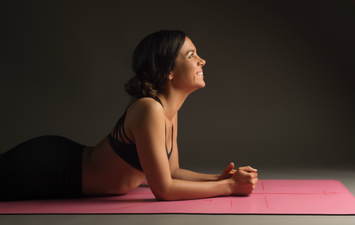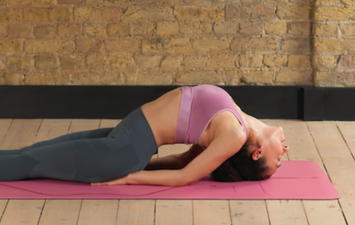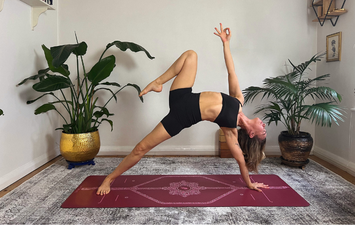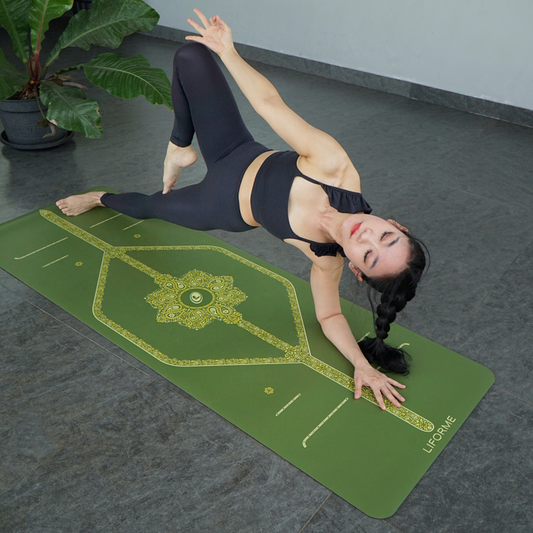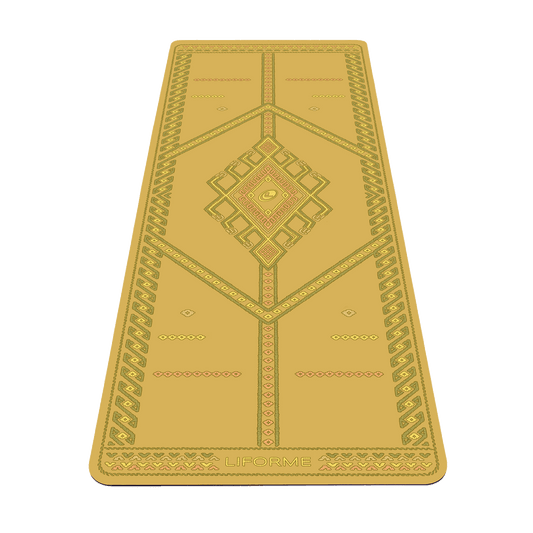International yoga teacher Mark Das is known as a handstand specialist. Now based in Bali, he reaches students worldwide through his online Handstand Academy. We recently chatted about his unique training, the role of handstanding in asana practice, and his teaching philosophy, both in the studio and on the internet. And he may or may not plug his favourite travel mat along the way. Let’s get to know Mark Das!
We know you have a background in both martial arts and gymnastics. How does yoga bring together aspects of those trainings?
When I was 21, I lived in a monastery in China where I immersed myself in Shaolin kung fu. The main reason that I went to China was to become a better martial artist, but I got so much more. I found out that movement was way more than just moving your body; there was this level of heightened awareness, of mindfulness, that went into the movement practice.
Seeing the kids that were living in the monastery, it didn’t really matter whether they were practising their martial arts or doing the dishes or eating their food, there was a similar focus to all of it. That’s how I saw that movement weaves into all aspects of life. The way they approach movement or martial arts is the way they approached life.
 I started gymnastics as an adult. I first got in touch with handstands in the Chinese monastery, and then in my gymnastic years at university from 22-24, I got better at handstanding. And I saw the same thing happening in gymnastics. The more focus and mindfulness you had in training, the better your practice was. The same focus was applied at all times. There was no difference in walking into the gymnasium, doing your dishes, or training.
I started gymnastics as an adult. I first got in touch with handstands in the Chinese monastery, and then in my gymnastic years at university from 22-24, I got better at handstanding. And I saw the same thing happening in gymnastics. The more focus and mindfulness you had in training, the better your practice was. The same focus was applied at all times. There was no difference in walking into the gymnasium, doing your dishes, or training.
This is what yoga is all about for me: The mindfulness, connection to yourself, and connecting to others. So when I started doing yoga, I was already able to fully engage both through mindfulness and through a solid practice. There are a lot of self-limiting beliefs to overcome with handstands, so the mindfulness and focus are very important, and have led me to develop my practice to what it is today.
What is it about handstands that particularly captures your interest?
When I first started doing handstands, I pretty much immediately fell in love. It was a very fun challenge. And the fun part was a process of constantly being at my limit.
It’s a little like a baby trying to learn how to stand on two feet. At first, they’ll be wobbly and shaky, as the nervous system and muscles are simply not used to the position. The baby will need some sort of an external aid, like a table top, a couch, or their parents. It’s a process in which the body is building the neural pathways, plus the muscle strength, and when exposed to standing on two feet for long enough, all of a sudden it will click. Something similar happens with handstanding. Your body just doesn’t know what it means to support itself upside down on two hands. I take time to develop the strength and the nervous system in the ways necessary in order to hold a handstand in the middle of the room comfortably and balance for a minute or two minutes. The road to get there is pretty long.
Something similar happens with handstanding. Your body just doesn’t know what it means to support itself upside down on two hands. I take time to develop the strength and the nervous system in the ways necessary in order to hold a handstand in the middle of the room comfortably and balance for a minute or two minutes. The road to get there is pretty long.
I’m the kind of guy that loves patterns, graphs, numbers, and repeating something over and over again to look for marginal improvements through videoing and analysing. I am relatively scientific in my handstand practice. That’s another part that makes it so interesting for me, because it requires you to do the same thing over and over again, and you will get smoother over time. Now, this is not for everyone. Some people like variety, and the thought of repetition makes them cringe!
Handstanding doesn’t make you a better person. It’s just another skill you can develop and a tool you can use to get to know yourself better. It takes a lot of energy and dedication, so the tool of a handstand has significantly (over eight years practice) improved my patience and my dedication, and also the level to which I allow myself to have a break. Because handstands are a lifelong journey; there will always be something to improve, which means I can be a lot nicer to myself.
We often talk about yoga as a body-mind practice. What’s the mental side of handstanding? Do you find it has any particular mental benefits?
There are many mental benefits to handstanding itself. The first is overcoming self-limiting beliefs. The stories that we tell ourselves. ‘What if I hurt myself? I’m not strong enough. I’m too clumsy.’ They almost justify NOT practising, even if we have a strong yearning to learn. When we hold onto these beliefs, we live in the realm of possibilities. Everything would be possible if ONLY you weren’t this, or if ONLY you weren’t that. If we live in that realm all the time, it is a very safe space.
As soon as you take that first step on the road to a handstand, by joining a workshop, or committing to a regular practice, that’s when you start to realise, ‘Oh perhaps I can do this, I am progressing and learning, and will be able to do this’. Slowly but surely you’ll start chipping away at those self-limiting beliefs. One of the things I see is the ripple effect; that boost in self-confidence ripples throughout other areas of their life. I had a ’ground-bound’ student who really struggled to kick up to a handstand. She came to a week-long immersion in Bali and on the fourth or fifth day she overcame her fear of kicking up. Then after she went back home to her normal life, she noticed that she felt so much more powerful. If I can do handstands, and overcome that fear what else can I do or overcome to allow my passions to flourish?
One of the things I see is the ripple effect; that boost in self-confidence ripples throughout other areas of their life. I had a ’ground-bound’ student who really struggled to kick up to a handstand. She came to a week-long immersion in Bali and on the fourth or fifth day she overcame her fear of kicking up. Then after she went back home to her normal life, she noticed that she felt so much more powerful. If I can do handstands, and overcome that fear what else can I do or overcome to allow my passions to flourish?
What’s your teaching philosophy?
As a teacher, it’s not about me, it’s about my students. There are a couple of things I always keep in mind. The first is a model of competence, autonomy, and relatedness. Your student wants three things. The first is to feel competent, a sense they can do something; the second is they want to feel they can do it on their own; and the third is a sense of relatedness, a way of feeling connected. This is something I always have in the back of my mind. The other idea that I work with is that it doesn’t matter how many students are in front of me, there are always three types: the beginner student, intermediate student, and advanced student. And I want to always tailor to all three.
I start all classes with a circle where we talk and meet each other. And then at the end we do the same thing to close. So even though handstanding is a solo practice, it is beneficial to do it in a solid community of people who have got your back, and when teaching handstands, the safe environment is MOST important. Keep them safe at all times. Jump in to help if they are not ready for the next stage. Teach them the skill of spotting, how they can help each other. Again, as a teacher, it’s not about me. I’m last to leave, so they can ask as many questions as they want. By it not being about me, I’ve been able to really be of service to my students, and significantly contribute to their handstand practice. I have a passion for teaching in general. I absolutely love it. I have taught in different movement modalities and forms, given guest lectures at my old university. Along the way, I developed a passion for handstands and now I can combine the two.
Again, as a teacher, it’s not about me. I’m last to leave, so they can ask as many questions as they want. By it not being about me, I’ve been able to really be of service to my students, and significantly contribute to their handstand practice. I have a passion for teaching in general. I absolutely love it. I have taught in different movement modalities and forms, given guest lectures at my old university. Along the way, I developed a passion for handstands and now I can combine the two.
What is teaching handstands to yoga practitioners online like?
I’ve been doing this for a while and it’s very empowering for both the students and for me. I have options for two- and six-month private handstand coaching programs on my website. Initially, I was quite sceptical about it, but it really does seem to work well for handstands specifically. I noticed students are more committed, more likely to keep it going. As an international yoga teacher, I am only in a city once or twice a year, so there can be a lack of continuity with my students, and with that sometimes a struggle to progress to where they want to be. But this online model has given me and my students much better continuity.
As an international yoga teacher, I am only in a city once or twice a year, so there can be a lack of continuity with my students, and with that sometimes a struggle to progress to where they want to be. But this online model has given me and my students much better continuity.
What’s your top travel tip?
I’ve been traveling solo for 11-12 years on and off. In between, I’ve lived in the Netherlands and China, and now I’m living in Bali. When I started travelling, I always took SOOOO much stuff. Anything I could think I might potentially need. So there was always way too much weight on my back. So my top tip is: travel light!
I’ve been honing down the volume I take with me, and this has then developed into living a minimalist lifestyle. Everything I own fits in my small backpack. This allows me to take it with me as cabin luggage and on my scooter because it’s so portable. I also take a Liforme Travel Mat with me. So that’s it! It helps me to realise that I can live life with very little, just the essentials: clothes, a few books, my mat, and a few technical devices.
 What’s your favourite travel destination?
What’s your favourite travel destination?
I live in Bali and I absolutely love it. I love the mountains, the rice fields, the friendly people. The climate, the weather, the same sunrise and sunset times throughout the year. It’s a place it feels good to call home. Go and explore the mountains, the waterfalls, the sheer cliffs where you can watch the sunsets and see the amazing coral from up high. Empty beaches looking for seashells, meeting farmers who are so friendly even if I can’t communicate much with them! The kindness and friendliness of the locals shines through.
If you opened a Yoga Studio, what would you call it?
No plans but I do have dreams! Right now the Handstand Academy is the online version of this community. So if I were to develop a studio it would be a physical representation of my online community, and it would revolve around handstands and teaching. So it would be called the Handstand Academy.
Image credit: @nickypearsprout, @dylanwernerphotography and @oc_rome


 What’s your favourite travel destination?
What’s your favourite travel destination?



